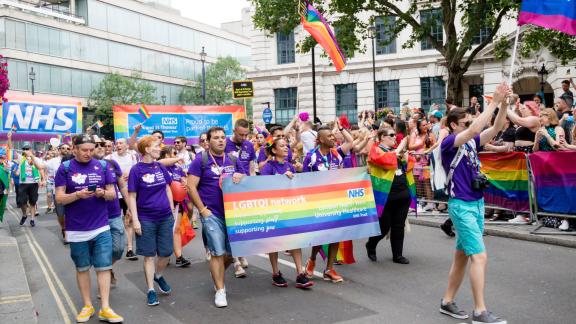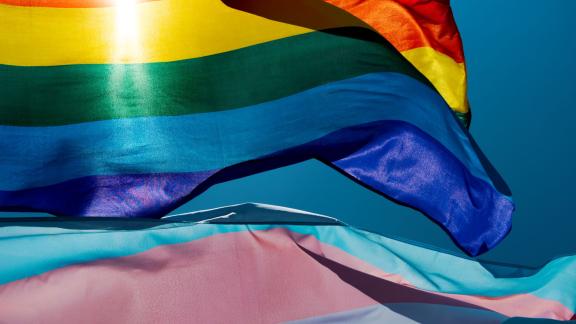Have you heard of International Lesbian Visibility Day?

Despite existing for over a decade, International Lesbian Visibility Day is little known. Dr Julie Scanlon, who specialises in equality and diversity, explains why this day is important for recognising and celebrating the contributions of lesbians, and making sure they are included, valued and engaged.
If you answered ‘no’, that you haven’t heard of International Lesbian Visibility Day, you’re probably in the majority!
It’s International Lesbian Visibility Day on 26 April. The day has, ironically, until recently, been quite an invisible visibility day although it has existed since 2008.
I first became aware of Lesbian Visibility Day in 2019. I’m a lesbian myself and I’ve previously worked as an academic and researched lesbian visibility, been involved in community groups etc, but it took over ten years for me to become aware there was a day devoted to people like me.
Why had we never heard of it? Why was no one marking it or celebrating it? Just as I was contemplating these questions, the UK-based magazine DIVA - ‘the world’s best-selling magazine for LGBTQI women’ – announced they were making a week of it and launched Lesbian Visibility Week, 2020. Events for 2020 moved online due to the COVID-19 pandemic and 2021 sees another week of online activities planned.
Do we really need another day in the diversity calendar?
The short answer is ‘yes’.
While all visibility (and similar celebration) days have their limitations if they stop only at being publicity exercises, if they are backed up with genuine actions to advance those they claim to serve, they are good opportunities to support people’s sense of feeling valued and as though they belong.
You might be thinking, aren’t lesbians ‘covered’ in LGBT History Month or in Pride activities, or in women’s networks and celebrations of International Women’s Day? Well, ‘yes’ and ‘no’. Lesbians exist at an intersection that can sometimes fall between the gaps.
Various studies indicate that many women do not feel comfortable or engage with activities targeted at LGBT+ umbrella communities. For example a 2018 survey by HER, a social networking and dating app for LGBTQ+ women found that 31 per cent of their respondents did not feel welcome or comfortable at Pride.
In the NHS, the 2020 research on Understanding LGBT+ Employee Networks and How to Support Them found that network membership was dominated by gay men (42 per cent) and that only 22 per cent of the members were lesbians. This composition is far from unique to the NHS. The research also found that Pride involvement came second place only to network meetings when members were asked about the activities of the network. Given the focus on Pride, and some lesbians’ finding Pride unappealing, the activities of the networks may well not be serving the diverse communities they aim to serve.
In workplace networks for women in general, lesbians are obviously a minority and activities can skew toward the heteronormative (assuming heterosexuality is the norm). Evidence on lesbians’ experiences of the (US) workplace in relation to other women can be found in McKinsey’s report, Women in the Workplace (2019). 23 per cent of lesbians reported feeling that they could not talk about themselves or their life outside of work, compared to 10 per cent of women overall (26 per cent bisexual women expressed this). 24 per cent of lesbians reported hearing demeaning remarks about them or people like them, compared to 16 per cent of women overall. Most concerning is the fact that 53 per cent of lesbians reported experiencing sexual harassment in the workplace, compared to 41 per cent of women overall (62 per cent of bisexual women expressed this).
These figures are stark and show a need to understand intersectional differences and the impact they have. (Unfortunately, McKinsey’s report published in 2020 refers to LGBTQ+ women in general, preventing an update on analysis of the experiences of lesbians or bisexual women in particular).
What should we be doing?
Celebrating lesbian visibility day is one way to recognise the contributions that lesbians make, to foster understanding between different groups and to acknowledge that more needs to be done.
Beyond this day, there is a need to understand whether or not lesbians are feeling included, valued and engaged or what might improve this.
In the raft of diversity and inclusion activities – policy-making, using inclusive language and visuals, for example – we benefit from remembering that the LGBT+ umbrella is capacious and diverse and that lesbians are not a homogenous group within that.
So, I leave you with a small challenge – what is one action that you can take this week to support lesbian visibility? Go ahead and do it!
Dr Julie Scanlon is a consultant, trainer, facilitator and executive coach. Find out more at www.juliescanlon.co.uk and follow her on Twitter @julie_scan



